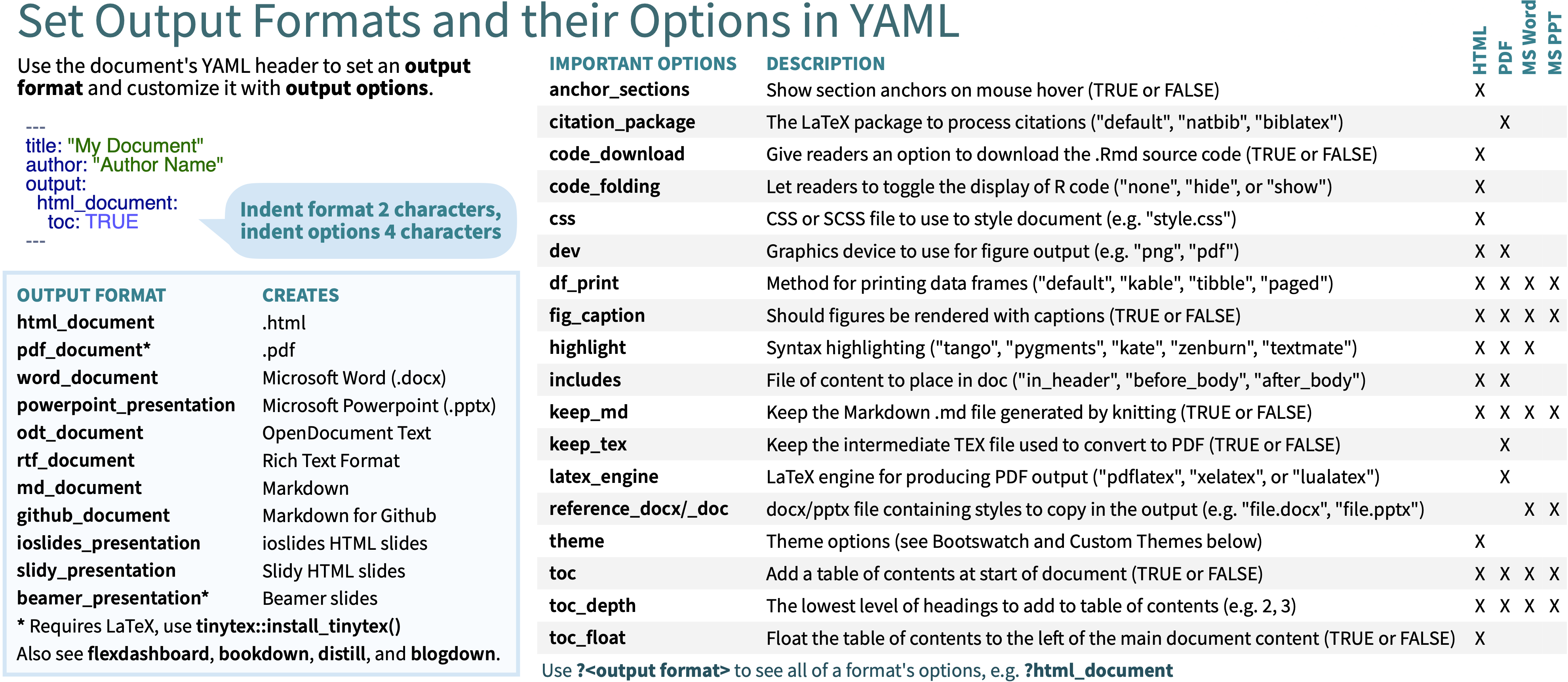Components of an R Markdown Document - The YAML header#
What is the YAML header?#
A YAML header is the very first component worth adding to an R Markdown file. Conceptually, it is a short block of text occuring at the start of an R Markdown file that can be used to define metadata for the file as well as instructions on how the R Markdown file should be processed and how to style the output.
What does a YAML header look like?#
The YAML header is itself comprised of key-value pairs that are enclosed above and below by triple-dash (---) lines. An example YAML header is as follows:
---
title: "My html document"
author: "John Smith"
date: "2025-04-29"
output: html_document
---
In this particular example, the following YAML key-value pairs have been used:
Key |
Value |
|---|---|
title |
“my html document” |
author |
“John Smith” |
date |
“2025-04-29” |
output |
html_document |
Here, the title, author and date YAML keys act to define metadata for the file and their assigned values will get displayed in the resultant output. The output format is itself controlled by the output YAML key, which in this case has been assigned the value html_document (note the lack of quotation marks) so that a HTML output gets produced.
It is worthwile noting that the date key does not necessarily have to be assigned a fixed value. If you’d prefer to set things up so that the current date is always given in the output when the R Markdown file gets processed, you could replace the written date as follows:
---
title: "My html document"
author: "John Smith"
date: "`r Sys.Date()`"
output: html_document
---
The r Sys.Date() syntax used here also provides an example of how R code can embedded into R Markdown documents. We will explore this in more detail later on in the workshop.
Is HTML the only output option in a YAML header?#
The title, author and date fields are core metadata keys of a YAML header in R Markdown documents. Nevertheless, if desired, each can be ignored by setting the assigned value to NULL or by simply removing the corresponding line of code. While we will focus on HTML outputs in this workshop for simplicity (can be viewed on a web browser), there are many other possible options that exist when it comes to controlling the output format in a YAML header using the output key. For example, we can instruct for a Microsoft Word document (.docx) to get produced when the R Markdown file is processed via the following:
---
title: "My html document"
author: "John Smith"
date: "`r Sys.Date()`"
output: word_document
---
Some output options can be leveraged regardless of output format, whereas others are only valid for specific types of output format. The most common output types and options when defining the output key of a YAML header are as follows (sourced from R Markdown: The Definitive Guide (PDF)):

It is worthwhile noting that when specifying additional options for outputs via the output YAML key, it is convention to specify additional options (which can be considered as ‘sub-keys’) each on a new line with tab spacing implemented. For example, if we wished to ultimately produce a HTML output that includes a table of contents, we could use the following YAML header in our R Markdown document:
---
title: "My html document"
author: "John Smith"
date: "`r Sys.Date()`"
output: html_document:
toc: TRUE
---
Task#
In your working R Markdown file, create a YAML header that will:
Give your output the title “Skeletal Muscle and Exercise”
Incude your name as the author
Generate whatever the current date is anytime the
.Rmdfile gets processedProduces a HTML output when the
.Rmdfile is processed
